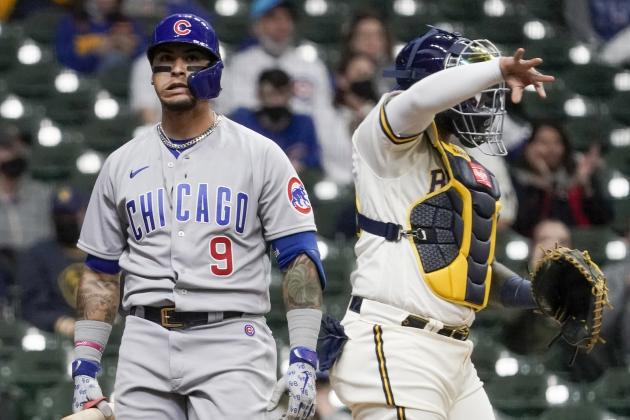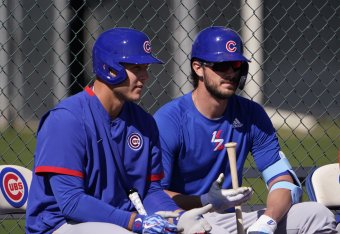Featured Video
Judge Short Porch Homer 🔥

Cubs' Ice-Cold Start Paving the Way to Trade Deadline Fire Sale
With 15 games played, the Chicago Cubs are only through about 10 percent of their 2021 season. By all rights, it should be too soon for definitive judgments.
It's not looking so good, however.
After winning the division for the third time in five years in 2020, the Cubs now find themselves in last place in the National League Central with a 6-9 record. They're specifically struggling at the plate, where they're hitting an MLB-low .192 and scoring just 3.4 runs per game.
TOP NEWS

The Most Likely Player to Be Traded for Every MLB Team in 2025

Cooking Up Paul Skenes Blockbuster Trade Packages amid Pirates Struggles

1 MLB Offseason Mulligan Every Team Wishes It Had
Of course, this is happening on the heels of the Cubs taking their first steps into a rebuild over the winter by waving goodbye to chief executive Theo Epstein and stars like Yu Darvish, Jon Lester and Kyle Schwarber.
It's therefore hard not to consider which steps the Cubs might take next, and when.
NL Central Standings
- 1. Cincinnati Reds: 9-6
- 2. Milwaukee Brewers: 9-7
- 3. St. Louis Cardinals: 8-8
- 4. Pittsburgh Pirates: 7-9
- 5. Chicago Cubs: 6-9
The Cubs Have Very Real Problems
After the coronavirus pandemic delayed the start of the 2020 season until late July, the Cubs started last year hot with 13 wins in 16 games. It looked then like they might be capable of returning to the World Series after winning it and thereby snapping a 108-year curse in 2016.
What actually happened was that the Cubs went 21-23 over their last 44 games, in large part because their offense flatlined with a .678 OPS and 4.1 runs per game. Those offensive struggles continued in the NL Wild Card Series, as the Cubs scored just one run in a two-game sweep at the hands of the Miami Marlins.
Given the contest of last season combined with the offseason departures of Schwarber, Victor Caratini and others, it's not the biggest surprise that Chicago's offensive issues have carried into 2021. It also shows in peripheral stats, such as the NL's lowest contact rate and a league-low .137 average with runners in scoring position.
Most alarming, though, is how Cubs hitters are failing to hit good heat.
The league-wide percentage of fastballs that clock at 95 mph or higher has recently been trending up and now stands at 24.6 percent. Yet if any Cubs hitters are thinking that number sounds low, it's probably because 31 percent of the fastballs they've seen so far this season have been at least 95 mph.
Those very fastballs are a problem the Cubs have yet to solve. Their weighted on-base average—which is basically a fancy version of OPS—against 95-plus heat is just .195, the worst such mark in baseball.

Lest anyone think the Cubs offense is entirely to blame for the team's slow start, its starting rotation ranks 28th with a 5.91 ERA and has a fastball problem in its own right.
With Darvish out of the equation, the Cubs are short on starters who can light up the radar gun. Mainly courtesy of soft-tossers Kyle Hendricks and Zach Davies, their rotation's average fastball is just 89.6 mph. That's on track for the lowest mark of any group of starters over the past five seasons.
You can say that velocity alone doesn't make or break a fastball, but it does help. Since Cubs starters rank 25th in wOBA against their heaters, they can vouch.
Alas, the Cubs can't exactly make their starters throw harder. And while there might be a way for manager David Ross and hitting coach Anthony Iapoce to fix the offense's fastball problem, it doesn't bode well that its roots go back to last year's modest .304 wOBA (tied for 20th) against 95-plus heat.
There Is a Silver Lining Here
Suffice it to say, the Cubs aren't the only team in the NL Central that has issues.
Though the Cincinnati Reds sit atop the division, the offensive surge that helped them win six of their first seven games has faded. In losing five of their past eight, they've conjured up memories of last year's historically bad offense by hitting just .218/.283/.368 with 3.5 runs per game.
The Milwaukee Brewers also have offensive problems, so much so that their collective .206/.296/.357 line works out to a 78 OPS+ that actually ranks them below the Cubs. Unless Christian Yelich both recovers from his bad back and turns his clock back to 2018/2019, that problem won't have an easy fix.
For their part, the St. Louis Cardinals are one team that actually has a worse rotation ERA than the Cubs at 5.97. And there isn't much hope of an immediate turnaround. Young right-hander Dakota Hudson (Tommy John surgery) is out for the season. Veteran righty Miles Mikolas (shoulder soreness) should be back, but his last competitive pitch was all the way back in October 2019.
This just leaves the Pittsburgh Pirates, who came into this year hoping for any sign of progress after going an MLB-worst 19-41 last year. Their 7-9 record actually makes the grade in that respect, but there's little reason to think it's the start of a Cinderella run.
All this is to say that the NL Central still looks as winnable now as it did coming into the year. Even if the Cubs so much as tread water for the rest of the season, they might still back into their fourth division title since 2016.
It is nonetheless noteworthy that the odds didn't favor them to begin with and, naturally, haven't improved. FanGraphs, for example, has the Cubs' chances of winning the NL Central down from 19 percent on Opening Day to nine percent now.
The Cubs Could Have Some Valuable Trade Chips
If the Cubs continue to lose games and force their playoff chances further south in the process, they could look to finish what they started over the winter at this year's July 30 trade deadline.
With only Hendricks, Jason Heyward and David Bote guaranteed any money beyond 2021, it's not as if the Cubs' current roster is built for the long haul. What's more, a farm system that we ranked at No. 18 in MLB at the outset of the year could use a substantial infusion of talent.
At the least, the Cubs could look to rent out their pending free agents if they're out of it come July. Namely, long-time lineup mainstays Kris Bryant, Anthony Rizzo and Javier Baez.

With a vintage 177 OPS+ to his name so far, Bryant is reclaiming much of the trade value that he lost amid a career-worst season in 2020. By way of a 133 OPS+, Rizzo is also boosting his trade value.
Because he's struck out a league-high 27 times while posting a .214 average and a .267 OBP, Baez is hewing too close for comfort to the .203 and .238 marks he had in those departments last season. But in his power (four home runs), speed (five stolen bases) and Gold Glove-winning defense at shortstop, he still has at least three things that could draw a crowd at the trade deadline.
Given that his $16 million option for 2022 is unlikely to vest, the Cubs could also interest teams in closer Craig Kimbrel. He was having a hard time for a while dating back to last year, but he's looked a lot more like his All-Star self as he's whiffed 24 batters and allowed three hits and no runs in 14 appearances since last September.
Right-hander Jake Arrieta and outfielder Joc Pederson, both of whom have $10 million mutual options for 2022, could also become trade bait under the right circumstances.
Arrieta would merely need to keep up the warm start that's led him to a 3.18 ERA through three outings. For his part, Pederson would have to leave behind his frigid start (7-for-47) and hit more like he did in spring training, when he a 1.431 OPS and eight long balls.
Even though he's under their control through next season, the Cubs would also have to consider moving catcher Willson Contreras if he stays hot after starting this year with a 179 OPS+ and five home runs. After all, a lot of teams would love to have a bat like that behind the plate.
Again, a trade deadline fire sale might not happen if the Cubs can so much as hang around in an NL Central that doesn't have a true favorite.
But between their potentially unfixable flaws and their less-than-clear future beyond 2021, such a sale is beginning to feel less like a possibility and more like an inevitability.
Stats courtesy of Baseball Reference, FanGraphs and Baseball Savant.






